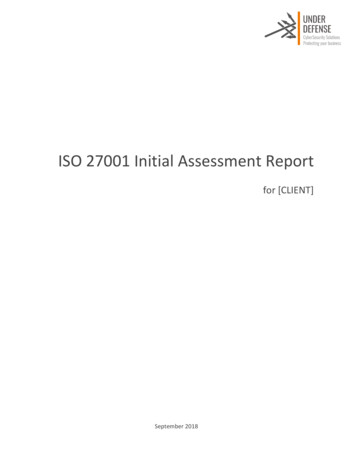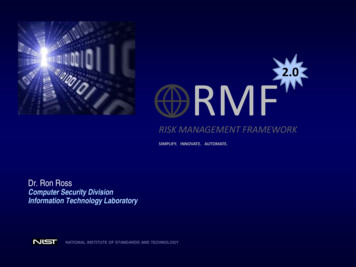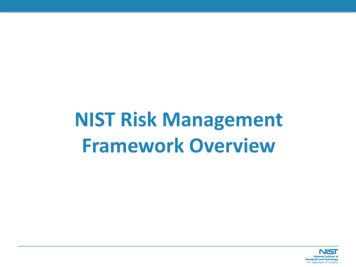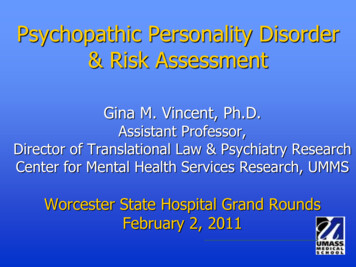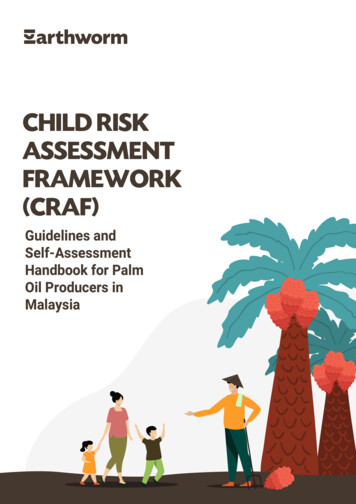
Transcription
CHILD RISKASSESSMENTFRAMEWORK(CRAF)Guidelines andSelf-AssessmentHandbook for PalmOil Producers inMalaysia
Copyright Earthworm Foundation 2020First published in 2020DisclaimerThis document does not claim to be an exhaustive set of guidance, norshould the content be treated as static. Instead, it contains an initialsummary of potential options for adapting established good practice.It will be treated as a working document that will be further refined asthe situation and the response continues to evolve. Every reasonableeffort is made to ensure that it is correct and up to date. The informationcontained in this document may be changed or updated at any timewithout notice. No warranty is made in relation to the contents of thisdocument. Readers should take their own independent legal or businessadvice. Earthworm Foundation (EF) is not liable for any loss, damage,adverse commercial impact or inconvenience you may experience asa result of using the information we provide. The materials in theseguidelines, including texts and images, are protected by copyright. Thisdocument and the information it contain may not be copied, reproduced,reproduction, quotation, reference or other similar use of this materialwithout prior written consent from EF.iCHILD RISK ASSESSMENT FRAMEWORK
About UsEarthworm Foundation (EF) is an impact-driven non-profit that works on the ground tocreate conditions for nature and people to thrive. Partnering with businesses, civil societiesand governments, EF focuses on implementing responsible sourcing commitments in valuechains, innovating practical solutions to the social and environmental challenges of productionpractices, and catalysing industry-wide chain reactions to help achieve transformation at scale.Children in Plantations (CiP) is Earthworm’s programme to protect the rights of children inthe palm plantation sector, with a focus on Sabah, Malaysia. EF Malaysia works mainly withcompanies in the palm oil industries to identify issues affecting children in plantations and todevelop solutions to mitigate the risks faced by children.Earthworm Foundation (EF) extends a special thank you to ADM Cares, Nestle and PZ Cussonsfor supporting the development and publication of the Child Risk Assessment Framework(CRAF).For more information about Earthworm Foundation, visit our webpage at www.earthworm.orgFor those interested in collaborating/ supporting the Children in Plantations initiative,please contact Lynda Lim (Malaysia) at l.lim [at] earthworm.org / at 60 3 2201 2393 orinfo[at] earthworm.org (HQ) / at 41 022 367 9440
ContentsAbout Child Risk Assessment FrameworkivGlossary1Background Context of Children in Plantations3What Makes a Child or Young Person at Risk in Palm Oil Plantations?4A Brief Snapshot of the National Legal Framework that is Relevant for Children in Plantations5Toolkit 1: Risks Relating to Child Labour & Young Workers in Palm Oil Plantations7Definition of Child, Children in Employment and Child Labour in Malaysia8What Can Companies Do to Prevent Child Labour?10What Can Companies Do To Mitigate the Occupational, Safety and Health Risk ofYoung Workers?13Mitigating the Risk of Child Labour: Remedies14Self-Assessment19Toolkit 2: Risks Relating to Education & Child Care23What companies can do to support the education of workers’ children23Self-Assessment24Toolkit 3: Risks related to Maternity Protection, Healthcare & Nutrition26What can company do to mitigate the risks for female workers during pregnancy,child birth and throughout breastfeeding period?26Self-Assessment27Healthcare and Nutrition27Self-Assessment28Toolkit 4: Risks Related to Birth Registration31What a Company can do to help workers’ children to obtain birth registration?31Self-Assessment32Toolkit 5: Risks Related to Child Protection34Child Sexual Exploitation, Violence and Abuse in Palm Oil Plantations34How Can a Company Help Prevent Child Sexual Exploitation, Violence and Abuse?35How to Provide Remedy to Child Survivor of Sexual Exploitation, Violence and Abuse37Self-Assessment39Toolkit 6: Risks Related to Onsite Safety, Accommodation, Water & Sanitation42What A Company Can Do to Mitigate On-Site Safety Risk42Self-Assessment43What A Company Can Do to Improve the Living Conditions of Children?44Self-Assessment45Annex 146List of Resources47iiiCHILD RISK ASSESSMENT FRAMEWORK
About the Child Risk Assessment Framework (CRAF)ContextThe social impacts of the palm oil sector on children’s well-being have been under heightened scrutiny in recentmonths. Associated Press investigations have found child labour1, allegations of sexual exploitation, abuse andexposure of pregnant workers to chemicals linked to palm oil plantations in Malaysia. Recently, the industryalso witnessed action taken in response to some of these issues when US Custom and Border Protectionbanned the import of palm oil and palm oil products from one Malaysian producer. The prevalence of thesesocial and human rights issues put palm oil producer companies risk of reputational damage, exclusion fromsupply chains, financial liabilities if fines are imposed, and restricted market access.“Children are affected in multiple ways by the palm oil sector-as dependent of workers, membersof the community, and at times, workers themselves. Child labour has long been a recognisedconcern in the industry. However, the impact of the sector on children extends beyond childlabour. Children living in remote areas-in and around palm oil plantations have limited access toeducation, healthcare, decent living conditions, clean water, sanitation, birth the registration, andthey are also vulnerable to sexual exploitation and abuse. A lack of protection for pregnant andnursing female workers is also a key concern and will directly and indirectly have an impact onchildren. Due to poverty, these children also experience poor nutrition” ----UNICEF2What is Child Risk Assessment Framework (CRAF)?This CRAF is a guidance document with six toolkits of guidelines and self-assessment frameworks for palmoil producer companies to: Identify potential risks faced by children in palm oil plantationsDevelop policies, procedures and interventions to minimise risk by responding in a timely manner tothe identified potential risksRemediate adverse impacts discoveredReview whether adequate measures have been taken to prevent, eliminate or reduce these risksMake oil palm plantation sites and the surrounding areas a safe place to work and to live, for childrenand for young peopleThis CRAF was designed for palm oil plantation companies in Sabah, Malaysia, but it can be adapted toother industries and locations where children and young persons are present. It aims to help companies tounderstand and to apply the requirement of international standards such as the ILO Conventions onChild Labour & Worst Form of Labour, the industrial standards and criteria of the Roundtable on SustainablePalm Oil (RSPO), the national legislation, customers’ standards or buyer’s requirements.1 422 See Palm Oil and Children in Indonesia: Exploring the Sector’s Impact on Children’s Rights, UNICEF, 2016 available at LD RISK ASSESSMENT FRAMEWORKiv
Who Should Use the Child Risk Assessment Framework (CRAF)?It has been developed for human resource managers, estate managers, mill managers, sustainabilityofficers and Fresh Fruit Bunches (FFB) procurement team.Why Should Companies Undertake a Child Risk Assessment?The UN Convention on the Rights of the Child (CRC)3 recognises the fundamental human dignity of allchildren and the urgency of ensuring their well-being and development. It makes clear the idea thata basic quality of life should be the right of all children, rather than a privilege enjoyed by a few. Asset out in the UNICEF Children Rights and Business Principles4 , companies have responsibilities toprevent and address risks to child rights in their business operations.Because these issues deserve care and close attention, companies need to employ a holistic approachto protect children in plantations. This is to ensure that: children are safe where they live, learn and play; they are free from child labour; young workers’ safety is protected; girls and boys have access to education that build their skills and capacities, with or withoutdocumentation; children are registered at birth; children at heightened risks of sexual exploitation and abuse are identified and assisted; pregnant workers and breastfeeding mothers are protected from performing tasks that will harmthe foetus/baby’s’health; and to reduce the morbidity and mortality of children by ensuring adequate access to healthcareservices, clean water and sanitation, decent living condition and good nutritionHow to Use the CRAF?There are six toolkits in this document. Each toolkit is divided into two sections: The first section of each toolkit provides guidelines on what companies can do to prevent andto mitigate specific types of risks faced by children and young people in plantations. The second section contains assessment criteria that companies can use to self-assess itspractices in the prevention and mitigation of risks.Ideally, companies are strongly recommended to work closely with third party organisations or serviceproviders that have technical expertise in child protection, children’s education, early childhood,gender- based violence (GBV) and maternal health, to implement the guidelines and to conduct theself-assessments in these toolkits.Tips Consider the CRAF as a menu of options to pick and choose depending on your company’s need.It is up to you to decide which sections and toolkits are relevant for your particular situation.This document can be read in full by those who are interested- in gaining an in-depthunderstanding of the issues, or it can be used as a reference guide for information on specifictopics.3 -child-rights/4 https://www.unicef.org/corporate partners/index 25078.htmlvCHILD RISK ASSESSMENT FRAMEWORK
Why Are Children’s Rights Relevant forPalm Oil Producers?Children are people in their own right, just likethe adults, with contributions to make andideas to share. They are human beings and arethe subject of their own rights. Respect forchildren’s right is a right thing to do both for thecompany and its workforce.Company has legalobligation to complywith the national laws inMalaysia.Company needs to manageits reputation- child labourputs company at a greaterrisk of reputational damagewhich can lead to exclusionfrom supply chain, and inorder to run your businesswithout interruption/ andopposition, you need toensure good reputation.Companies have the responsibility to make suretheir staff and business operations do no harmto children, and companies’ activities do notexpose children to the risk of harm and abuse,and are obligated to address those risks withmeasures that establish child-safe companies.Company has the corporateresponsibility to respectchildren’s rights -- avoiding anyinfringement of the human rightsof others, including children, andaddressing any adverse humanrights impact with which thebusiness is involved.To stay in business or to grow your business, companyneeds to comply to several industry standards, legal,buyer and creditor’s requirements, as internationalbuyers will require proof that business is free of childlabour.CHILD RISK ASSESSMENT FRAMEWORKvi
Glossary1TermDescriptionBest Interest ofthe ChildWhen a decision or intervention is made about a child’s situation, it must ensure the end goal is toprotect the security and safety, the well-being and development of the child.ChildAccording to the United Nations, a child is any person under the age of 18.Child LabourChild labour is work performed by children that is mentally, physically, socially or morally dangerousand harmful to children, affecting their health and personal development, or that interferes withtheir schooling - whether or not work performed by children is defined as child labour depends onthe child’s age, the hours and type of work and the conditions in which the work is performed5.Child RightsAll children have the right to be treated with dignity and fairness, to be protected, to develop to theirfull potential and to participate. The Convention of the Rights of the Child CRC) sets out the civil,political, economic, social and cultural rights that everyone under 18 is entitled to6.Child Rights DueDiligenceAn approach that enables companies to identify, prevent, address and monitor the direct andindirect impact they may have or contribute towards on children as a result of their businesspractices – in the workplace and beyond.Child SexualAbuseRefers to any form of sexual activity with a child by an adult or by another child who has powerover the child. By this definition, it is possible for a child to be sexually abused by another child.Child sexual abuse often involves body contact7.ConfidentialitySurvivors have the right to choose to whom they will or will not tell their story, and any informationabout them should only be shared with their informed consent8DisclosureThe process of revealing information. Disclosure in the context of sexual abuse refers specificallyto how a non-offending person (for example, company employee, teacher or helper) learns abouta child’s experience with sexual abuse.9Do No HarmApproachA ‘do no harm’ approach involves taking all measures necessary to avoid exposing people tofurther harm as a result of the actions of humanitarian actors.10Gender- basedViolence (GBV)Gender-based violence (GBV) is an umbrella term for any harmful act that is perpetrated againsta person’s will and that is based on socially ascribed (i.e. gender) differences between males andfemales11HazardA danger or risk - anything that has the potential to cause harm.Hazardous WorkRefers to work undertaken in dangerous or unhealthy conditions that could result in a child beingkilled or injured/harmed due to poor safety and health standards in work place.ILO ConventionsRefers to international agreement on an important labour-related issue that has been reachedby governments, workers and employers meeting at the annual International Labour Conferenceof the ILO. Ratification may involve the inclusion of provisions specific to the circumstances ofthe country. Once ratified, the country is bound to carry out the provisions of the Convention (asratified). The ILO reviews the implementation of Conventions and holds countries accountable12Light WorkThe Convention No.138 on Minimum Age for Work defines light work for children as:a) unlikely to be harmful to their health or developmentb) not such as to prejudice their attendance at school, their participation in vocational orientationor training programmes approved by the competent authority, or their capacity to benefit from theinstruction receivedCHILD RISK ASSESSMENT FRAMEWORK
MandatoryReportingThis refers to state laws and policies which mandate certain agencies and/or persons in helpingprofessions (teachers, social workers, health staff, etc.) to report actual or suspected child abuse(e.g., physical, sexual, neglect, emotional and psychological abuse, unlawful sexual intercourse13Service providersEducation, Health and psychosocial service providers charged with providing direct services tochildren and/or survivors of gender-based violence. These professionals include caseworkers,social workers, health workers, child protection workers, gender officersSexualExploitationAny actual or attempted abuse of a position of vulnerability, differential power or trust for sexualpurposes. This includes profiting monetarily, socially or politically from the sexual exploitation ofanother (see also sexual abuse)14.SurvivorA person who has experienced gender-based violence. The terms “victim” and “survivor” can beused interchangeably. Although “victim” is generally preferred in the legal and medical sectors,and “survivor” in the psychological and social support sectors. Throughout CRA, we use “childsurvivor15”.Third-partysupplierRefers to any third-party supplier of goods or services to the Company that does not come underthe direct control of either the Company (first party) nor the customer/buyer (second party) in abusiness transaction.UN Convention ofthe Rights of theChild (CRC)An important agreement by countries who have promised to protect children’s rights. It explainswho children are, all their rights, and the responsibilities of governments. All the rights areconnected, they are all equally important and they cannot be taken away from children16UndocumentedmigrantRefers to a migrant worker who is not in possession of a valid work pass (pas lawatan kerjasementara - PLKS) in Malaysia.Worst Forms ofChild LabourThe worst form of child labour includes all types of slavery, including but not limited to the saleand trafficking of children; forced labour to pay off a debt; including using children in war andarmed conflict; all activities which sexually exploit children, such as prostitution, pornographicperformances; any involvement in illegal activities, especially the production or trafficking of drugs;any work which could damage the health, safety or well-being of children (so called “hazardouswork”)17.Young Persons inEmploymentNot all work done by children under the age of 18 is classified as child labour. The legislationallows for some forms of work to be undertaken by children under the age of 18. Participation indecent work which does not affect their health, personal development or education can be a verypositive experience for children or adolescents who have reached the required age18.5 Cited the ILO’s definition of child labour available at https://www.ilo.org/ipec/facts/lang--en/index.htm6 Cited the UNICEF UK Child Rights Partners factsheet, UNICEF, available at -content/uploads/sites/3/2016/08/CRC summary leafletChild Rights Partners web final.pdf7 Cited the Caring for Child Survivors of Sexual Abuse, IRC & UNICEF, 2010 available at ide-2012.pdf.pdf8 Cited the Minimum Standards for Prevention and Response to Gender Based Violence in Emergencies, UNFPA, 2015, available at GBVIE.Minimum.Standards.Publication.FINAL .ENG .pdf9 Cited the Caring for Child Survivors of Sexual Abuse, IRC & UNICEF, 2010 available at ide-2012.pdf.pdf10 Cited the Minimum Standards for Prevention and Response to Gender Based Violence in Emergencies, UNFPA, 2015, available at GBVIE.Minimum.Standards.Publication.FINAL .ENG .pdf11 Ibid12 Cited the Checkpoints for Companies: Eliminating and Preventing Child Labour, ILO, 2016 available at https://www.ilo.org/global/publications/WCMS 456960/lang--en/index.htmpubCited the Caring for Child Survivors of Sexual Abuse, IRC & UNICEF, 2010 available at ide-2012.pdf.pdf14 Ibid15 Ibid16 Cited the UNICEF ‘s definition of child rights available at -rights-child-text-child-friendly-version.pdf17 Cited ILO’s definition of worst forms of child labour available at 8 Cited the Checkpoints for Companies: Eliminating and Preventing Child Labour, ILO, 2016 available at https://www.ilo.org/global/publications/WCMS 456960/lang--en/index.htmCHILD RISK ASSESSMENT FRAMEWORK2
Background Context of Children in PlantationsNearly 85 % of global palm oil is produced in Indonesiaand Malaysia. Malaysia currently accounts for 28 %of the world’s palm oil production and 33% of worldexports13. There are 505,972 plantation workers inMalaysia14. The palm oil industry in Malaysia reliesheavily on migrant labour, which makes up 70-80% ofthe plantation workforce. It’s also a destination country,predominantly for undocumented labour migrantsfrom neighbouring Indonesia and Philippines. This isespecially apparent in the palm oil industry in Sabah.“Unlike in Peninsular Malaysia, as of 2015, foreignworkers in Sabah may be granted family visas, thusenabling them to bring their family members with them,on the condition that they earn RM2,500 (monthly) orabove. Indonesian and Filipino children are often seento migrate with their parents (legally and irregularly) toSabah, while some children of foreign workers wereborn in Sabah. The Government of Indonesia estimatedthat there are at least 60,000 Indonesian children livingaround plantation areas across Sabah, where some ofthem may be living in poverty with relatively little accessto education”15.Based on findings from the previous EarthwormFoundation consultation with companies in Sabahthat took place in 2017, it was found that childrenand young persons were involved in a number ofplantation activities including weeding at nurseries,stacking palm fruits, harvesting and manuring, slashing,collecting loose fruits and spraying16. These activitieswere reported to have taken place in both commercialplantations and small growers’ estates. The childrenand young people who were found to be involved inthese activities on commercial plantations were not onany official employment record.These findings are consistent with several empiricalstudies that have been conducted in Sabah, andaccording to ILO’s report17 migrant children were foundto be working on palm oil plantation sites. Some ofthese children work informally but on a full-time basis,and therefore miss out on education, assisting theirparents by undertaking tasks that might be harmfulto their health and safety. The Employment Survey inOil Palm Plantation, Malaysia 201818, published by theMinistry of Plantation Industries and Commodities(MPIC), estimated that 33,600 children aged 5-17 yearsold are child labour. The prevalence rate of child labourassociated with palm oil is 11.5% with Sarawak beingthe highest at 15.3%, followed by Sabah at 12.1%. Lessthan 500 children are in forced labour with the highestshare seen in Sabah at 86.2%. The majority of thesechildren are non-Malaysian citizens (85.5%) and aremainly between the age group of 15 and 17 years old19.In October 2020,the US Customs and BorderProtection (CBP) blocked the import of palm oil madeby a Malaysian producer over forced labour concernsincluding forced child labour20.The use of child labour is clearly prohibited in the NoDeforestation, No Peat and No Exploitation (NDPE)21commitments under the No Exploitation component.About 70% of the refining capacity in Malaysia andIndonesia is currently covered by NDPE policies.The Roundtable on Sustainable Palm Oil (RSPO)standards considers the protection of children’srights and their safety, including the prohibition ofchild labour on plantations, to be a priority22. Thisimplies that palm oil producers have the responsibilityto prohibit the use of child labour in their own businessoperations and in their supply chains. Malaysia hasratified the UN Conventions of the Rights of theChild (CRC), ILO Fundamental Conventions onMinimum Age Conventions (138), Worst Forms ofChild Labour Convention (C182) and Forced LabourConvention (C 29) which are of particular relevance oncombatting child labour, forced labour and humantrafficking23. Malaysia has ratified the Protocol toPrevent, Supress and Punish Trafficking in Persons,especially women and children.13 http://mpoc.org.my/malaysian-palm-oil-industry/14 ocal-labour-rights-in-the-palm-oil-sector15 Cited the Children in the Plantation of Sabah: Stakeholder Consultation Report, TFT, 2017, available at 6 Ibid17 Poulsen B., Too Yang-Tau., AB Wahab, A. Background Study on Strengthening Nation Action Plan To Address Child Labour in Malaysia: ILO Working Paper (Geneva, ILO), 201918 Cited the Employment Survey in Oil Palm Plantations, Malaysia 2018, Ministry of Plantation Industries and Commodities, 201819 Ibid20 -biggest-producers21 o-exploitation-ndpe22 https://rspo.org/library/lib files/preview/140423 Background on Strengthening National Action Plan To Address Child Labour in Malaysia (unpublished), ILO, 20193CHILD RISK ASSESSMENT FRAMEWORK
What Makes a Child or Young Person at Risk in Palm Oil Plantations?1. Lack of Documentation contributes to children at risk in Sabah. In particular,migrant children face multiple forms of discrimination that stem largely from theiruncertain legal status in Malaysia. The fear of arrest and detention has meantthat many migrant workers do not apply for birth certificates for their children.This can have wide-ranging impact as without a birth certificate, children aredenied access to education, healthcare, and other basic services. Children whoare not attending school are likely to start working at very young ages. Their lackof documentation and legal status means that they are without recourse in theevent of unfair treatment, abuse, violence or injury in the workplace.2. The Low Wages of Working Parents cause children and young persons to beat risk of being mobilised by their parents- to assist them to produce higheroutputs to earn enough money to live. Palm oil activities where children andyoung persons may be working include collecting loose fruits (children and youngpersons); harvesting and manuring (young persons); spraying (young persons);loading fresh fruit bunches (young persons); and slashing, which may posecommon safety and health hazards24.3. Medium and Small Size palm oil producers and third-party suppliers have limitedknowledge and awareness of the law. The Background Study on StrengtheningNation Action Plan To Address Child Labour in Malaysia, conducted by PoulsenB., Too Yang-Tau., AB Wahab, A., in 2019, pointed out that many companies arenot aware about what is permissible and non-permissible work for children andyoung people.4. Lack of Law Enforcement due to the limited number of labour inspectors,coupled with the remoteness of many plantations and oil palm companies, hasbeen the key challenge for enforcement agencies such as the Labour Departmentto undertake comprehensive monitoring of compliance to national laws andregulations concerning children and young workers25.5. Limited educational facilities and child care facilities (i.e. crèche) in oraround plantations have caused some parents to bring their children to work inplantations. This further risks children assisting their parents in their work. Somelearning centres are located far from their housing areas, and parents (workers)are reluctant to send their children to these learning centres. For young people,there are very limited options for continuing their secondary education.As such,these young people often seek employment in the same plantation where theirfamily members work.6. Gaps in Access to Healthcare in remote areas due to lack of transportation anddistance. Poulsen B., Too Yang-Tau., AB Wahab, A. found that many communitieshave to travel at least three hours along dangerous terrain or logging roads toreach the nearest clinic. There are also gaps in the overall quality of services,especially for children in rural areas and marginalised communities who facehealth concerns such as malnutrition.24 Children in Plantation of Sabah, Earthworm Foundation, 2018, available at n-Plantations-of-Sabah-2017-report.pdf25 Poulsen B., Too Yang-Tau., AB Wahab, A. Background Study on Strengthening Nation Action Plan To Address Child Labour in Malaysia: ILO Working Paper (Geneva, ILO), 2019CHILD RISK ASSESSMENT FRAMEWORK4
A Brief Snapshot of the National LegalFramework that is Relevant for Childrenin PlantationsLegislationScopeChild Act 200124 (Peninsular Malaysia, Provisions relating toSabah & Sarawak)rehabilitation of childrenthe care, protection andChildren & Young Persons’ (Employment) Has special provisions relating to the employment of(Amendment) Act 2019)25 (Peninsular children and young people in Peninsular Malaysia-e.g.Malaysia)working hours, types of works, hazardous list(For full details, refer to toolkit 1)Sabah Labour Ordinance 195026(For full details, refer to toolkit 1)Provisions relating to the employment of children andyoung people in SabahSarawak Labour Ordinance 195227(For full details, refer to toolkit 1)Provisions relating to the employment of children andyoung people in SarawakEducation Act 196628Provisions relating to education and mattersconnected therewithDomestic Violence Act 1994(Amendment 2017)29Related to the provision of legal, physical protectionand remedy in situations of domestic violenceSexual Offences against Children’s Act201730The law is aimed at protecting children aged 18 andbelow from sexual crimes which is in line with the ChildAct 2001.Workers’ Minimum Standards ofHousing and Amenities (Amendment)Act 2019 .-applicable to PeninsularMalaysia & Federal Territory of Labuan31The law outlines the responsibilities of employerto ensure that the accommodation provided toemployees and their families has decent amenities& facilities for the employees and the duties andresponsibilities listed out with regards to health andsafety.Anti-Trafficking in Persons & AntiSmuggling Act 2007(APTISOM Act)Peninsular Malaysia, Sabah andSarawakProvisions related to the prosecution of offenders, andprotection of victims particularly women and chil
What Makes a Child or Young Person at Risk in Palm Oil Plantations? 4 . Children living in remote areas-in and around palm oil plantations have limited access to education, healthcare, decent living conditions, clean water, sanitation, birth the registration, and . , or it can be used as a reference
